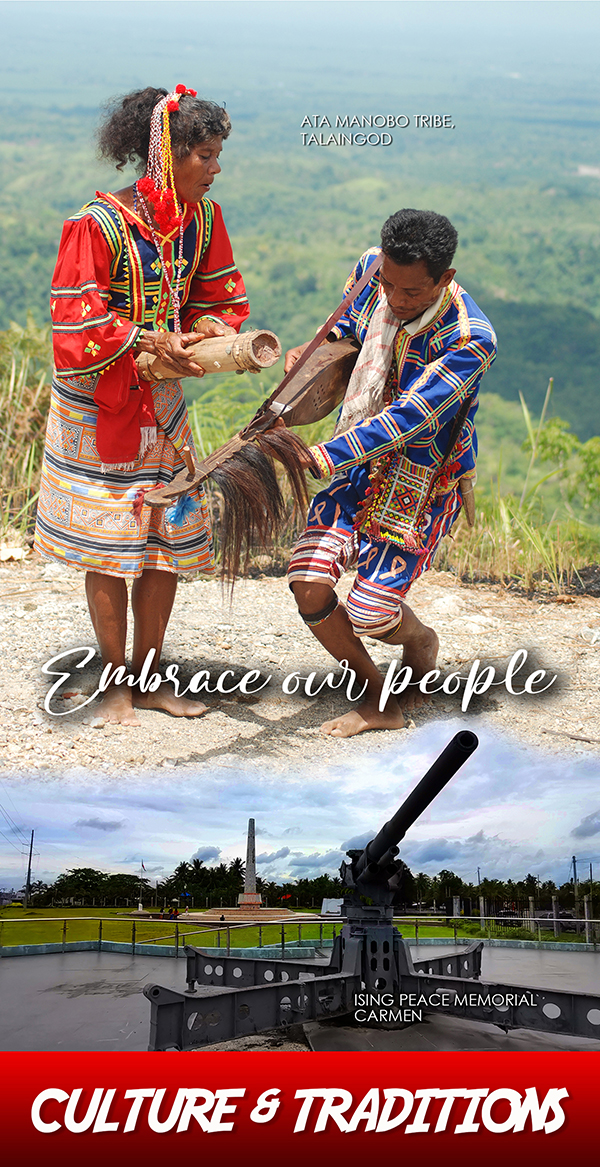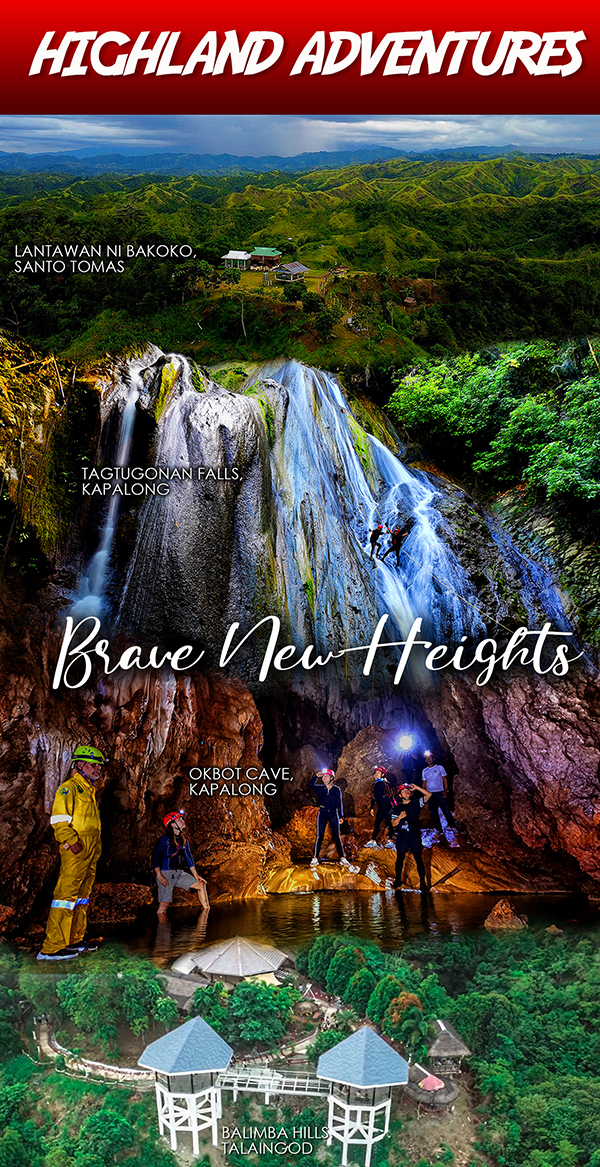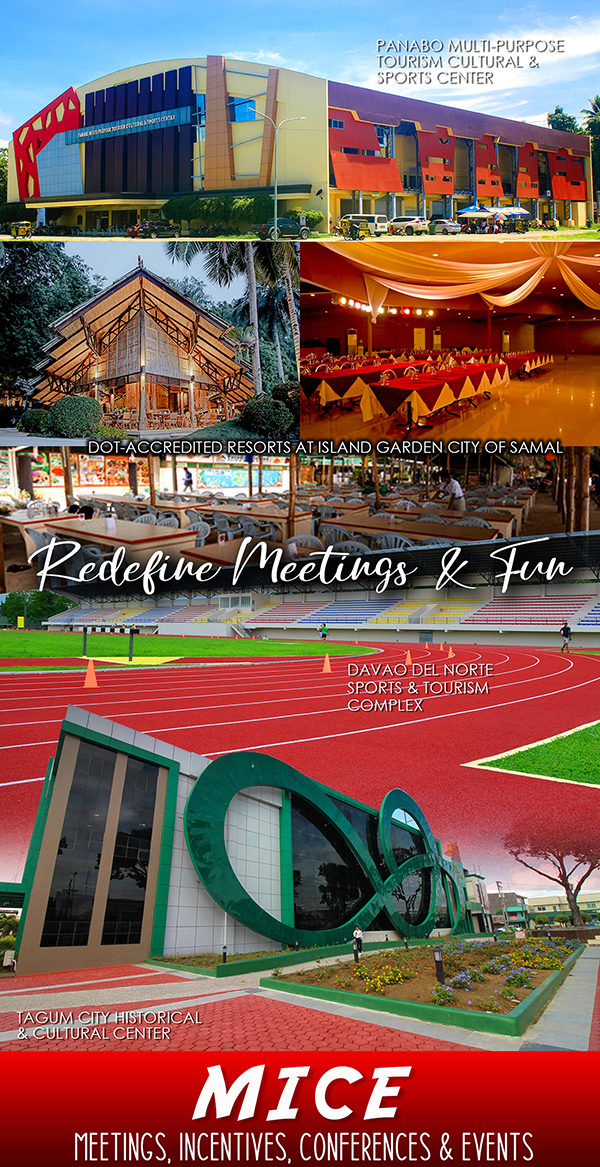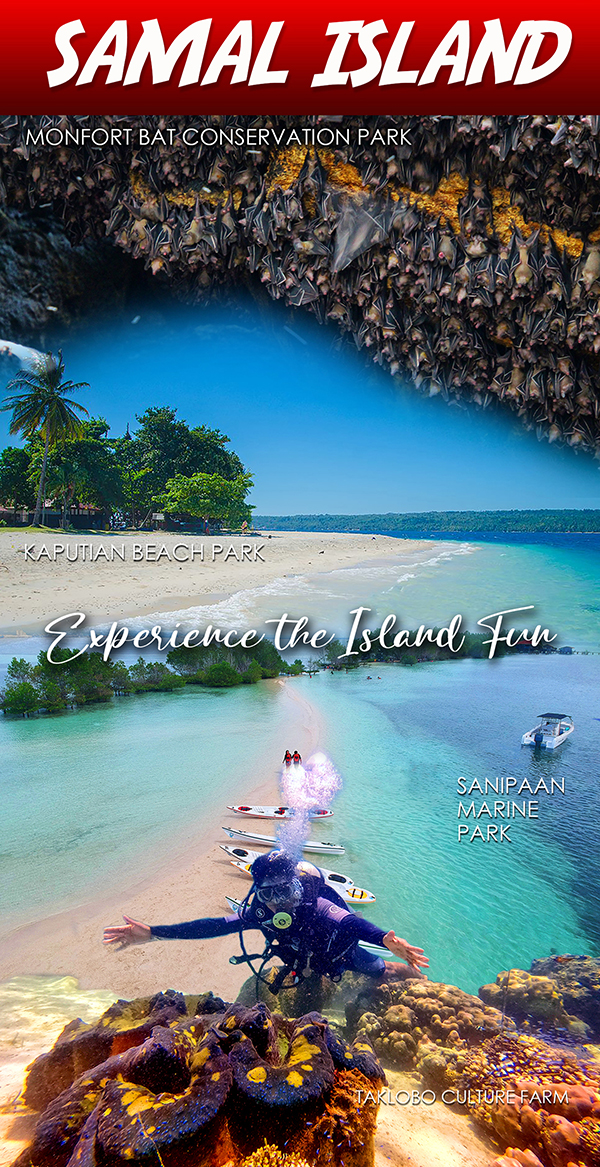
MUNICIPALITY OF ASUNCION
The calm allure of Madgao
Boats, long and narrow, are starting to arrive. It is a cloudy afternoon and the river is calm as the boats continue to create ripples on the surface. This is only one of the features of Madgao River which makes it an emerging tourist destination of Asuncion, Davao del Norte.
One of the boaters said that the river, more than two kilometers long, has been “like a highway” to them not only in terms of its usage but also its physical attributes. It offers an excellent training ground for dragon boat racing. It also abounds with carp, tilapia, and native prawn, among other aquatic resources.
Seek out the rural splendor of Asuncion, a municipality christened in honor of its patron saint, the Nuestra Senora dela Asuncion. A melting pot of cultures, this 30,422 hectare town used to be the bastion of Aeta and Mandaya tribes before migrants settled in the 1930s. Today, it is one of the provinces food baskets, producing high quality produce, such as rice, banana, corn, coconut, root crops, calamansi, various vegetables and fruits. It is also home of the Madgao River, known for its marine resources and an emerging tourist destination in the province.
MUNICIPALITY OF CARMEN
Once a battle ground, now a shrine
In May 1945 – the bravery of those who fought the war and drove away the Japanese army then stationed in Barangay Ising, Carmen town – will not be forgotten. The epic historic “Battle of Ising” is now remembered through a Veterans Memorial Shrine. Written there is a brief history and some of the names of those who risked their lives to win the battle that prompted the Japanese forces to leave Davao.
Now, Carmen is fast progressing first class municipality. It takes advantage of its fertile land and rich marine resources. Vast rice fields may be viewed along the national highway. Its coastal arrears are relied upon by the fisher folks as major source of livelihood such as mud-crab fattening and fishing.
A bastion of brave Filipino soldiers, this once-battleground is now a historical shrine in Davao del Norte. Carmen, a first-class municipality, where the epic Battle of Ising happened is now honored through the Ising Peace Memorial. Also in this town, you can find the Balutan sa Carmen a line of stalls selling “Balut” where the now famous grilled balut originated.
MUNICIPALITY OF BRAULIO E. DUJALI
When fishponds harbour rice lands – Organic Rice Farm
Home to integrated farming system, BE Dujali now becomes an embodiment of success in the countryside. With areas largely flooded especially during the rainy season, it has been turning tides to its favour by converting swampy areas into productive fishponds and organic rice fields, teaching its people the right farming systems – these as the municipal government installs and keeps up protection dikes to control the influx of water.
Discover Natures gifts in the once a swampy and uninhabited municipality of Braulio E. Dujali. Today, it is a model municipality visited by tourists - and emulated by others - for its organic demonstration farm, Palayamanan. The Farm showcases rice fields, vermiculture, goatery, duckery, piggery, vegetable and herbal gardens. Guests are also was served with delectable organic food straight from the farm.
Also attracting more visitors to this town is Payag ni Enards, a local restaurant that serves local cuisine.
ISLAND GARDEN CITY OF SAMAL
Pristine Paradise of IGACOS
From its white-sand beaches, to caves, falls and world renowned fruit bats, the Island Garden City of Samal is undoubtedly the prime face of tourism in the Davao region. It is definitely the island destination where Dabaonons can grab a quick summer escape. But more and more people from beyond are discovering it.
From Samal’s beach fronts, nature lovers can head inward to Hagimit Falls. Down the steps to the multi-tiered falls, the cool refreshing water attracts families and friends. In a province known for its fruits, it is no surprise that a certain wave of colony of bats has also called it home – the close to 2 million fruit bats of the Monfort Bat Conservation Park.
Plunge into the endless excitement that the Island Garden City of Samal has to offer. The jewel of Davao Gulf is a haven for various eco-adventure activities, such as diving, snorkeling, kayaking, canoeing, mountain climbing & biking, trekking, camping, spelunking, rappelling, rock/wall climbing, ziplines and water slides. Aside from its renowned white-sand beaches.
MUNICIPALITY OF KAPALONG
A theme park amid plantation
When visiting the town of Kapalong, touted as the “Caving Capital of Mindanao”, caves are must-see sites. But J.K. Mercado and Sons’ Pag-asa Farms is a destination one should not miss.
It has a five-hectare botanical garden within a vast banana plantation, in which a wide array of waling-waling and cattleya orchids thrive. The thrilling sight of different animal species await the visitors.
Situated across the Municipal Hall of Kapalong is the new Town Square cum theme park. The municipal government made a lagoon and a foot fountain on the corner that can be seen from the castle, where the round-shaped amphitheatre can clearly and be seen as well. While the latter has enough space for 1,800 people, an auditorium building was also built that can carry up to 2,000 people.
Kapalong is king when it comes to caves. It is home of the Suaon Nature Park, where a series of limestone caves formed intricate and mind-blowing natural formations underneath the earth. Visitors can explore Okbot, Otso, and Alena caves, and go sightseeing in the Sua-on Underground river. The town also has a five-hectare botanical and floral garden inside a vast banana plantation. Various animal species, including the endangered Philippine eagle, mouse, deer, and tarsier, are said to wander within the area.
Moreover, part of its extreme adventure is canyoneering at Tagtugonan Falls in barangay Gupitan.
MUNICIPALITY OF NEW CORELLA
DavNor’s water basin
Beat the summer heat under the cascading waters of Casilac Falls. Though it travels through a narrow strip that is only partly hidden from the scorching sun, the water falling and running down beds of limestone is still as cold as melted ice.
New Corella is beginning to be known for its refreshing inland resorts especially the more famous Panas Falls but Casilac Falls reigns as the tallest, measuring more than 20 feet.
Aside from its extensive forests where Lawaan, Guiho, Apitong and Narra trees as well as mineral resources thrive, New Corella is also known for its refreshing waterfalls. It is no wonder since this 26,312 hectare municipality is traversed by the mighty Saug River and seven gushing creeks that also provide irrigation to its vast farmlands. It is also one of the provinces biggest rice producers.
One may also explore the caves in this municipality. Highland destinations also abound as well as exciting trails for motor rides.
CITY OF PANABO
Gateway to export market
A land that produces world-class products and water that builds a booming industry, Panabo City is indeed destined to be the Agri-Industrial Gateway to the World.
Thriving along the booming Cavendish banana plantations on this part of the province are tons of bangus (milk fish) farmed in more than 400 fish cages spread out in three barangays of Panabo, namely JP Laurel, Cagangohan and San Pedro. These cages span 1,075 hectares making up what is known as the Panabo Mariculture Park.
The journey of this city to what it is now is being told in Museo Panabo, a general museum which features permanent exhibits that are divided into four halls: cultural, agri-industrial, political and contemporary.
Having the biggest banana plantations in the country has made Panado City instrumental in making the province the Banana Capital of the Philippines. Bananas from Panabo are exported to countries like Hong Kong, Singapore, Korea, China, Japan and the Middle East. The city is also famous for the success of its Mariculture Park, a magnet of investors and tourists alike who flock the site to gain knowledge about its salt-water bangus industry.
Recently, Panabo has added a number of tourist attractions and some of these are the Panabo Mangroves Eco Park a 73-hectare mangroves sanctuary & Agriya Naturetainment an 88-hectare agritourism development project.
MUNICIPALITY OF SAN ISIDRO
Land of “brown gold”, caves and waterfalls
San Isidro is famous for its ‘tableya’, round-shaped finished product of dried cacao beans which may have been the main ingredient of one’s favourite chocolate. But beyond its progressing cacao industry, eco-tourism sites also flourish.
Tagtugunan Falls and Kabyawan Cave are among the most-visited destinations aside from Datu Kugsing Cave and Sayaw Bat Cave despite the long walk that takes more than an hour.
Unknown to many, near Kabyawan is one more wonder shrouded by huge timber tress. The locals call it “Sambulawan Falls”, after the beautiful Sambulawan tree near the three-tiered waterfalls.
Nature’s bounties flourish in this town of 25,548 people, known for its world-class cacao products, exciting caves and magnificent waterfalls. San Isidro’s cacao industry is booming, along with its eco-tourism sites. Cacao products are being produced by the more popular Chokolate de San Isidro, a community based social enterprise in Sawata.
MUNICIPALITY OF STO. TOMAS
Model sanitary landfill where “crocs to go”
Santo Tomas is famous for its Municipal Eco-logical Park and Ecology Center, which has gained local and national attention. It has been yielding commendations since its inception in 2004, particularly from the Department of Environment and Natural Resources (DENR) as a “Model Site” and “Learning Institute”.
While other eco-parks possess a beauty perfected by the touch of nature, the town brings into existence the true picture of a clean and green environment starting from scratch.
A rising tourist magnet in town is 10-hectare property where you can find 6,000 crocodiles. Located in Brgy. New Katipunan is the Philippines’ second largest producer of; farmed crocodiles owned by J.K. Mercado and Sons Agricultural Enterprises, Inc. (JKMSAEI).
Other ecotourism sites also abound in Santo Tomas. Lantawan ni Bakoko, which is the jump-off point to the breathtaking beauty and wonders of Mount Megatong. Another pride of Santo Tomas is a river attraction named Suba ni Bukindaw.
CITY OF TAGUM
Spectacular Tagum
The City of Golden Opportunities, The Palm City of the Philippines, The Music Capital of the South, The City of Festivals, The Cultural Center of Mindanao and The City of Parks.
These are just some of the renowned titles the blooming capital City of Tagum has earned by now in just two decades of existence.
Fresh bananas remain as the chief export product of the city, ahead of other export goods like wood chips, veneer plywood, and wood lumber.
Adding to the list of its numerous man-made attractions, Tagum City is newest landmark is its Historical and Cultural Center which houses its public library, exhibition gallery, a heritage museum and a 1,000-seater theater which is the first of its kind in Davao Region.
MUNICIPALITY OF TALAINGOD
Rich Cultural Heritage
Native, indigenous, and the best word for it would be from the local dialect – Lumad. Famous for their Kalibulongan Festival, Lino’ob Food, Liyang-Bagtok and Highland View Park and Landscape, Talaingod or “Mountain people” was created on July 29, 1991 by virtue of RA 7081 which comprises of three barangay or villages, namely Barangay Dagohoy, Barangay Palma Gil and Barangay Sto. Nino.
Talaingod boasts of rich natural resources that include a 6,000-hectare virgin forest, the 500-ft Mt. Masimalon, the 60-meter Kalapat Falls, the Nabantalan Cave, the seven-hectare Kilomayon Lake and many more. Rubber, pineapple and abaca, upland rice and corn and coffee farming have their respective identified areas.
Ata-Manobo composes seventy two percent (72%) of the inhabitants of Talaingod. Cebuanos compose only 7% of the total population, while the Mandaya at 2.59%. Migrants from Bohol, Leyte, Iloilo, Ilocos, Agusan, Surigao and Davao compose the rest of the populace.
Journey into the tribal town of Talaingod, home of the Ata-Manobo tribe and Davao del Nortes living cultural showcase. Here, you can immerse with the tribes and experience their rich cultures, and celebrate with them the Kalibulongan Festival, a celebration of thanksgiving for a bountiful harvest.
Talaingod now has several jaw-dropping inland resorts that make the town a must-visit highland destination.
Provincial Administrator's Office - TOURISM DIVISION
Provincial Capitol Building, Barangay Mankilam, Tagum City, Davao del Norte Province, Region XI, Philippines. 8100
Tel No (084) 655-9485
e-mail: This email address is being protected from spambots. You need JavaScript enabled to view it.
facebook: davnorte tourism





























